1.Chinese Pulse Diagnosis 九分达人阅读第一篇
2015全国职称英语等级考试必看卫生类阅读理解译文
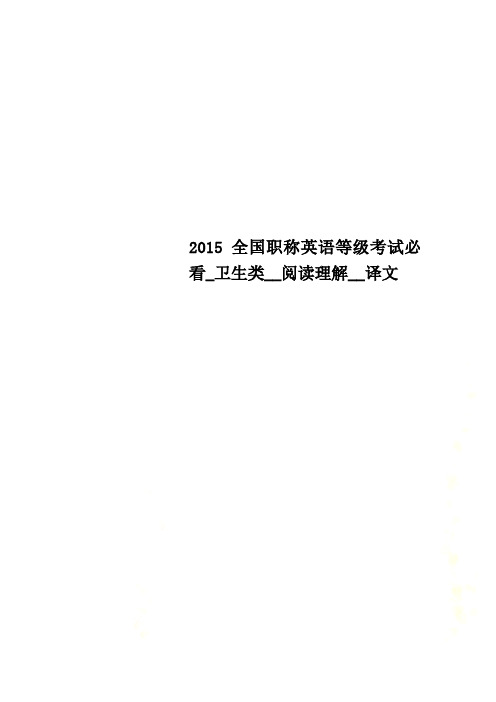
2015全国职称英语等级考试必看_卫生类__阅读理解__译文第四部分阅读理解第一部分 (ABC级)第一篇第一篇:纳米保健技术走向贫困国家纳米技术的应用对象都是分子级和原子级的物质。
如今,长度为一纳米,即十亿分之一米的粒子已被开发出多种用途,如制造美容产品和抗污型服装等。
但其中一个领域科学家认为潜力尤为巨大,那就是医药领域。
•在上周于华盛顿Woodrow Wilson国际中心召开的一个项目会议上,科学家们探讨了如何将纳米技术应用于贫困国家人口保健的事宜。
来自多伦多大学的Peter Singer声称一项名为量子点的纳米技术可被应用于疟疾的诊断。
相对于传统的仅用显微镜观察血液样本的方法,此技术要先进得多。
由于贫困国家往往没有条件应用此项新技术,许多健康人被误诊为疟疾患者,而药物的滥用又导致了抗药性的产生。
所谓量子点是指一些被激活后会发光的粒子,如今科学家正在研究为它们编程的方法,以便当靶分子存在的时候就能够通过发光来诊断疾病。
纳米技术的优越性不光体现在疾病的诊断,还包括疾病的治疗。
国立卫生研究所的Piotr Grodzinski与大家共同探讨了如何运用纳米技术来增强药效。
以一些已经使用了纳米技术的抗癌药物为例,他指出,如果药物可以针对癌症病灶而不是整个人体,治疗所需药量就会大大减少,副作用也会降低。
Andrew Maynard是Woodrow Wilson中心新兴的纳米技术工程部骨干科学家,他注意到巴西、印度、中国及南非正在开发可被贫困国家所应用的纳米技术。
与此同时他指出,与较大分子不同,纳米材料的颗粒在人体内和体外环境中的作用可能有所不同,因此纳米技术的应用存在一定风险,若要深入研究这些风险则需要更大的资金投入。
第二篇:医学期刊医学杂志医学杂志是向医生和其他医务人员提供医学信息的出版物。
在过去,这些杂志只有印刷版。
随着电子出版的发展,许多医学杂志现在都有网站了,有些杂志只有网络版。
少数的医学杂志,如《美国医学会杂志》,被看做是普通医学杂志,因为它们涵盖了医学的许多领域。
9分达人系列文章与考题对应一览表

Test 1威廉·吉尔伯特与磁场学 2012年9月6日 2010年8月5日 2007年9月20日2007年1月20日2003年酷夏 2013年11月9日 2010年10月30日 2009年3月28日2009年1月10日 2007年9月20日业余自然爱好者 2011年4月2日 2007年12月13日Test 2如何识破说谎者 2014年1月25日 2013年8月29日 2012年1月12日2011年11月17日 2010年1月30日 2009年3月21日在右撇子世界里做左撇子 2011年9月17日 2010年1月30日苏联人的新工作制 2012年7月21日 2009年4月30日 2009年2月7日Test 3示例学习法 2013年10月26日 2011年9月15日 2009年2月7日新冰川时代 2012年2月18日 2009年11月19日 2009年9月26日2009年2月7日 2007年10月13日 2007年7月14日作物指南 2007年9月20日Test 4莫扎特效应 2009年3月14日 2007年12月13日蚂蚁和橘子 2011年6月25日 2007年9月1日音乐:我们共同的语言 2010年9月16日 2007年9月1日Test 5神奇的植物 2011年7月9日 2010年3月6日 2009年4月25日儿童文学 2011年10月29日 2011年7月9日 2010年3月6日2008年10月23日滑石粉 2013年1月5日 2010年3月6日Test 6成功的芬芳 2011年10月29日 2010年4月10日卡里尔夫人和石炭酸球 2014年1月11日 2011年5月19日 2010年4月10日交流的方式与冲突 2012年11月3日 2010年4月10日Test 7新西兰海藻 2009年8月8日 2008年8月9日 2007年10月25日乐观与健康 2010年7月31日 2008年2月23日 2007年4月21日哥伦比亚大交换 2007年3月31日Test 1Going Bananas 2013年10月12日 2011年1月8日 2008年5月22日2007年6月9日 2006年8月26日 2006年5月27日Coastal Archaeology of Britain 2011年1月8日 2008年11月29日 2007年12月1日Travel Books 2011年1月8日Test 2Ambergris 2012年11月8日 2010年7月10日 2007年8月18日2006年6月17日Tackling Hunger in Msekeni 2013年3月2日 2010年7月10日Placebo Effect─The Power of Nothing 2010年7月10日Test 3Going Nowhere Fast 2014年2月13日 2011年2月12日 2008年3月29日The Seedhunters 2011年5月7日 2008年10月11日 2008年2月2日Assessing the Risk 2011年2月12日 2010年1月19日 2007年8月25日Test 4The Origins of Laughter 2010年9月4日 2008年7月12日The Lost City 2013年10月10日 2010年9月4日 2008年11月15日Designed to Last: Could Better Design Cure Our Throwaway Culture? 2010年9月4日Test 5Alfred Nobel 2012年8月4日 2011年4月30日Bird Migration 2014年1月18日 2013年6月8日 2012年5月10日The Ingenuity Gap 2013年12月7日 2010年7月31日Test 6Man or Machine? 2012年9月1日 2010年12月16日 2008年6月21日California’s Age of Megafires 2011年11月26日The Rainmaker 2010年12月18日 2006年9月23日Test 7Health in the Wild 2012年12月1日 2012年1月7日 2011年1月15日2009年9月12日The Conquest of Malaria in Italy, 1900-1962 2011年11月5日 2009年9月5日 Sunset for the Oil Business? 2013年8月29日 2011年7月30日 2010年3月20日Section 12014年1月25日2011年12月1日 2006年9月2日Section 2 The Schedule of Annual Conference on Mastering Computer Languages 2006年5月27日2005年12月3日 2005年3月19日Section 3 Asking for Advice on Choosing Courses 2012年11月3日2008年6月21日 2006年11月18日 2006年1月21日2005年7月9日Section 4 How to Choose Flooring Materials2012年8月25日2011年10月29日 2007年6月2日 2006年10月14日2006年3月25日 2005年7月16日 2005年5月28日Section 1 2012年9月1日2009年7月23日Section 2 Looking for V olunteer WorkersVersion 07106Section 3 Environmental Change Brought by Farming2010年7月15日2005年5月21日Section 4 Insects and Pest Control2012年9月22日2007年12月1日 2006年2月11日 2005年3月19日Section 1 Returning the Rice Cooker2008年11月15日2007年10月13日 2007年8月16日Section 2 A Map of the University of New South Wales2010年12月4日 2009年12月19日2014.2.22考题Children’s education is expensive. In some countries, the government pays some of or all of the costs. Do the advantages outweigh its disadvantages?对应书中题目: P113 Question 9 & P133 Question 15, 相似度99%2014.2.15考题Some people think the success of life is based on hard work and determination, but others think there are there are more important factors like money and personal appearance. Discuss both views and give your own opinion.对应书中题目:P177 Question 26, 相似度 60%2014.2.13考题Towns and cities are attractive places. Some suggest the government should spend money putting in more works of art like paintings and statues to make them better to live in. To what extent do you agree or disagree?对应书中题目:P229 Question 40, 相似度 80%2014.2.1考题Some people believe that the best way to produce a happier society is to ensure that there are only small differences between the richest and the poorest members. To what extent do you agree or disagree?对应书中题目:P201 Question 32,相似度 60%2014.1.25考题The international community must act immediately to ensure that all countries reduce the consumption of fossil fuels (e.g. gas and oil). To what extent do you agree or disagree with this statement?对应书中题目:P212 Question 35,相似度99%2014.1.18考题Children find it hard to concentrate on or pay attention to school? What are the reasons? How can we solve this problem?对应书中题目:P93 Question 4,相似度60%2014.1.11考题Nowadays many young people in the workforce change their jobs or careers every few years. What do you think are the reasons for this? Do the advantages outweigh the disadvantages?对应书中题目:P101 Question 6 & P356 Question 29.6, 相似度70%2014.1.9考题The best way for the government to solve traffic congestion is to provide free public trans-port 24 hours a day, 7days a week. To what extent do you agree or disagree?对应书中题目:P143 Question 17, 相似度60%。
1.Chinese Pulse Diagnosis 九分达人阅读第一篇
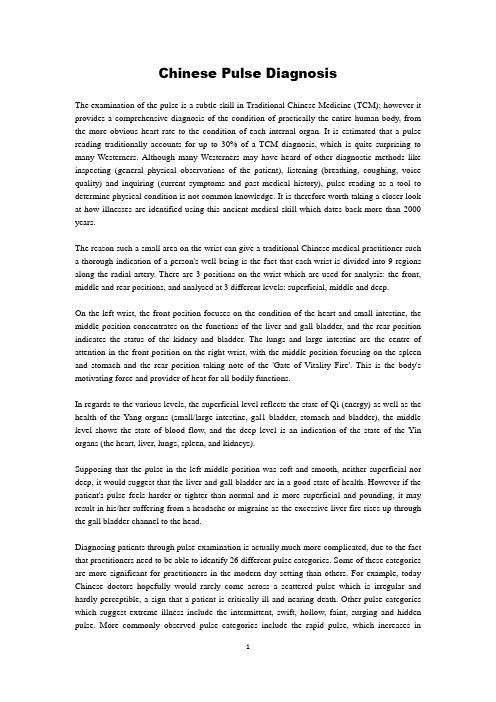
Chinese Pulse DiagnosisThe examination of the pulse is a subtle skill in Traditional Chinese Medicine (TCM); however it provides a comprehensive diagnosis of the condition of practically the entire human body, from the more obvious heart rate to the condition of each internal organ. It is estimated that a pulse reading traditionally accounts for up to 30% of a TCM diagnosis, which is quite surprising to many Westerners. Although many Westerners may have heard of other diagnostic methods like inspecting (general physical observations of the patient), listening (breathing, coughing, voice quality) and inquiring (current symptoms and past medical history), pulse reading as a tool to determine physical condition is not common knowledge. It is therefore worth taking a closer look at how illnesses are identified using this ancient medical skill which dates back more than 2000 years.The reason such a small area on the wrist can give a traditional Chinese medical practitioner such a thorough indication of a person's well-being is the fact that each wrist is divided into 9 regions along the radial artery. There are 3 positions on the wrist which are used for analysis: the front, middle and rear positions, and analysed at 3 different levels: superficial, middle and deep.On the left wrist, the front position focuses on the condition of the heart and small intestine, the middle position concentrates on the functions of the liver and gall bladder, and the rear position indicates the status of the kidney and bladder. The lungs and large intestine are the centre of attention in the front position on the right wrist, with the middle position focusing on the spleen and stomach and the rear position taking note of the 'Gate of Vitality Fire'. This is the body's motivating force and provider of heat for all bodily functions.In regards to the various levels, the superficial level reflects the state of Qi (energy) as well as the health of the Yang organs (small/large intestine, gal1 bladder, stomach and bladder), the middle level shows the state of blood flow, and the deep level is an indication of the state of the Yin organs (the heart, liver, lungs, spleen, and kidneys).Supposing that the pulse in the left middle position was soft and smooth, neither superficial nor deep, it would suggest that the liver and gall bladder are in a good state of health. However if the patient's pulse feels harder or tighter than normal and is more superficial and pounding, it may result in his/her suffering from a headache or migraine as the excessive liver fire rises up through the gall bladder channel to the head.Diagnosing patients through pulse examination is actually much more complicated, due to the fact that practitioners need to be able to identify 26 different pulse categories. Some of these categories are more significant for practitioners in the modern day setting than others. For example, today Chinese doctors hopefully would rarely come across a scattered pulse which is irregular and hardly perceptible, a sign that a patient is critically ill and nearing death. Other pulse categories which suggest extreme illness include the intermittent, swift, hollow, faint, surging and hidden pulse. More commonly observed pulse categories include the rapid pulse, which increases infrequency (more than 90 beats per minute) and may be indicative of a fever, or the tense pulse, which feels like a stretched cord, and may suggest that the patient has a cold or is suffering from pain. Many pulses only have subtle differences or are the combination of several pulses; thus, pulse examination is often seen as being more than just a skill but an actual art form.This kind of medical diagnosis can be affected by a number of factors, so before any examination, it is important that patients are in a relaxed physical and mental state so they can get the most accurate reading. The morning is often the best time to take such a reading, as a busy day in the office or vigorous exercise before seeing the doctor can influence the quality of the pulse. Secondly, both the patient's and the doctor's arm, hand, wrist and fingers must be relaxed and in the correct position. Thirdly, the right amount of pressure must be applied by the doctor for the right duration of time in order to be effective. Even seasonal influences need to be taken into account. In the spring, the pulse tends to be slightly taut; in summer, it is slightly fuller and surging. The autumn pulse is somewhat floating, fine and soft while the winter pulse is rather sinking and slippery or hard. Patients' characteristics are also of importance. Children, for instance, have quick pulses, athletes have slower than usual ones, and obese people have deeper ones. Women have stronger right pulses than their left, as opposed to men where the opposite is true. Finally drug use, either pharmaceuticals or narcotics, can have an influence on a patient's pulse.The basic form of a patient's pulse will be able to tell a doctor whether the function being observed is at the body's surface or interior, whether it is hot or cold in nature, and whether an excess or deficiency in that particular function exists. It ought to be remembered that pulse examination does not replace other types of medical diagnosis, which also play an integral role in the overall prognosis of the patient.Questions 1-2Complete the sentences below using information from Reading Passage.Write NO MORE THAN TWO WORDS for each answer.1 Pulse reading is a tool used by Chinese medical practitioners to __________ the state of apatient's health,2 Diagnostic tools, such as inspecting, listening and inquiring to analyse a patient's condition,are much more __________ than pulse examination.Questions 3-4Complete the diagram below.Write ONLY ONE WORD for each answer.Right HandQuestions 5- 7Complete the table below.Write NO MORE THAN THREE WORDS for each answer.Questions 8-9Choose the appropriate letters A-H.Which TWO factors are NOT mentioned as possibly influencing the accuracy of a pulse reading?A Physical examinationB Time of dayC WorkD Position of upper limbsE Amount of force usedF ClimateG Illegal substancesH ChemistsQuestions 10-12Do the following statements agree with the information given in Reading Passage? Write TRUE if the statement is true according to the passageFALSE if the statement is false according to the passageNOT GIVEN if the information is not given in the passagePulse TypeDescription Possible Condition(s) ScatteredNot obvious/intermittent Almost _____5_____ _____6_____Intensifying beats per second High temperature Tight _____7_____ Flu, aches & sorenessLarge _____3_____ Gate of Vitality Fire _____4_____ and digestive organ10 Most Westerners are intrigued by Chinese pulse diagnosis.11 Your liver is probably fine if the pulse on the right wrist is soft and smooth in the middleposition.12 Pulse diagnosis is one part of a broader medical examination.Question 13Choose the appropriate letter A-D.13 The writer believes pulse readingA is simplistic in nature.B is unimportant and no longer necessary.C requires practitioners to be familiar with Chinese history.D requires lengthy study and practice.。
语法填空(公众健康与中医文化)-备战2024年高考英语一轮复习查漏补缺大闯关100道必刷题(解析版)

专题30 语法填空公众健康与中医文化话题练名校精选练1.(2023·全国·模拟预测)阅读下面短文,在空白处填入1个适当的单词或括号内单词的正确形式。
Robots are highly beneficial to healthcare. Statistics show that around 16 million patients in China are 1 need of orthopedic (矫形外科的) surgery. Surgical robots help surgeons figure out the problem, 2 carry the risk of exposing both surgeons and patients to radiation damage. The all-in-one orthopedic robot (AIOOR) solves this problem. Developed by orthopedic 3 (special) Zhang Yuanzhi and his team, AIOOR is the first of its kind in China. Its cutting-edge imaging system and software 4 (short) the time needed for complex operations, such as those for spinal injuries, and also makes such surgeries much 5 (safe).Advanced robotics, moreover, considerably eases patients’ discomfort created by the traditional gastroscopy (胃镜), 6 requires that the physician put a tube down the patient’s mouth to the stomach. The discomfort is unbearable to many patients, 7 (make) some avoid checkups and consequently miss the best time for treatment. The NaviCam, a system developed by ANKON Medical Technologies in Shanghai, enables 8 (entire) painless stomach visualization instead. Patients only need to “eat” 9 capsule-sized robot, and the examination is completed within 15 minutes. After the procedure, the robot is removed from pa tients’ body. So far, these robots 10 (employ) in about 1,000 medical centers across China.【答案】1.in 2.but 3.specialist 4.shortens 5.safer 6.which 7.making8.entirely 9.a 10.have been employed【导语】本文是一篇说明文。
9分达人1月8日考试解析

<!--[if !supportLists]-->9. <!--[endif]-->利用细节信息“consumers would not accept”定位于原文最后一段第三行David McLaughlin的观点“there are serious questions about consumer acceptance”,原文“genetically altered crop”对应前一句中的GM(genetic modification的缩写),所以答案为B。
<!--[if !supportLists]-->3. <!--[endif]-->利用细节信息“wild banana’s taste”和顺序原则定位于第一段第四行“the wild banana…contains a mass of hard seeds that make the fruit virtually inedible”,题目信息“adversely affected”对应原文“virtually inedible”,所以答案为hard seeds或seeds。
Questions 11-13
<!--[if !supportLists]-->11. <!--[endif]-->利用细节信息“oldest known fruit”定位于原文第一段第一句话“the banana is among the world’s oldest crops”。在原文这个信息的基础上,题目可能为True,也可能为False,所以答案为Not Given。
<!--[if !supportLists]-->13. <!--[endif]-->利用细节信息“main food”定位于原文第六段开头几句话“Half a billion people in Asia and Africa depend on bananas…Its name is synonymous with food…”。题目信息与原文是同意表达,所以答案为True。
九分达人阅读6test1passage3
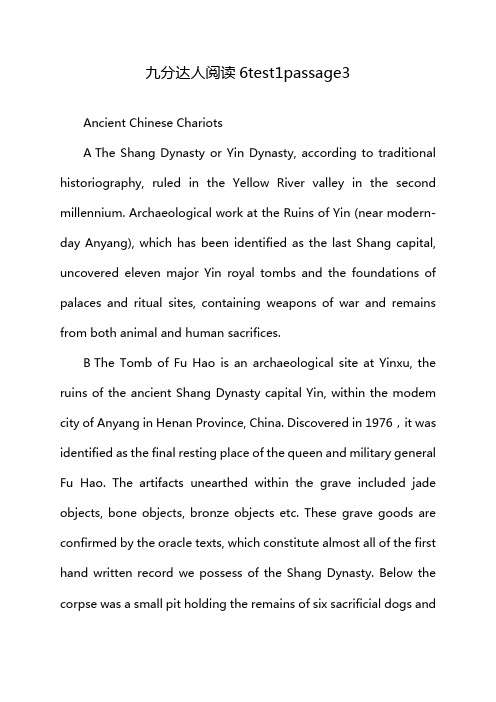
九分达人阅读6test1passage3Ancient Chinese ChariotsA The Shang Dynasty or Yin Dynasty, according to traditional historiography, ruled in the Yellow River valley in the second millennium. Archaeological work at the Ruins of Yin (near modern-day Anyang), which has been identified as the last Shang capital, uncovered eleven major Yin royal tombs and the foundations of palaces and ritual sites, containing weapons of war and remains from both animal and human sacrifices.B The Tomb of Fu Hao is an archaeological site at Yinxu, the ruins of the ancient Shang Dynasty capital Yin, within the modem city of Anyang in Henan Province, China. Discovered in 1976,it was identified as the final resting place of the queen and military general Fu Hao. The artifacts unearthed within the grave included jade objects, bone objects, bronze objects etc. These grave goods are confirmed by the oracle texts, which constitute almost all of the first hand written record we possess of the Shang Dynasty. Below the corpse was a small pit holding the remains of six sacrificial dogs andalong the edge lay the skeletons of human slaves, evidence of human sacrifice.C The Terracotta Army was discovered on 29 March 1974 to the east of Xian in Shaanxi. The terracotta soldiers were accidentally discovered when a group of local farmers was digging a well during a drought around 1.6 km (1 mile) east of the Qin Emperors tomb around at Mount Li (Lishan), a region riddled with underground springs and watercourses. Experts currently place the entire number of soldiers at 8,000 — with 130 chariots (130 cm long), 530 horses and 150 cavalry horses helping to ward of any dangers in the afterlife. In contrast, the burial of Tutank Hamun yielded six complete but dismantled chariots of unparalleled richness and sophistication. Each was designed for two people (90 cm long) and had its axle sawn through to enable it to be brought along the narrow corridor into the tomb.D Excavation of ancient Chinese chariots has confirmed the descriptions of them in the earliest texts. Wheels were constructed from a variety of woods: elm provided the hub, rose-wood the spokes and oak the felloes. The hub was drilled through to form anempty space into which the tampering axle was fitted, the whole being covered with leather to retain lubricating oil. Though the number of spokes varied, a wheel by the fourth century BC usually had eighteen to thirty-two of them. Records show how elaborate was the testing of each completed wheel: flotation and weighing were regarded as the best measures of balance, but even the empty spaces in the assembly were checked with millet grains. One outstanding constructional asset of the ancient Chinese wheel was dishing. Dishing refers to the dish-like shape of an advanced wooden wheel, which looks rather like a flat cone. On occasion they chose to strengthen a dished wheel with a pair of struts running from rim to rim on each of the hub. As these extra supports were inserted separately into the felloes, they would have added even greater strength to the wheel. Leather wrapped up the edge of the wheel aimed to retain bronze.E Within a millennium, however, Chinese chariot-makers had developed a vehicle with shafts, the precursor of the true carriage or cart. This design did not make its appearance in Europe until the end of the Roman Empire. Because the shafts curved upwards, andthe harness pressed against a horse’s shoulders, not his neck, the shaft chariot was incredibly efficient. The halberd was also part of chariot standard weaponry. This halberd usually measured well over 3 metres in length, which meant that a chariot warrior wielding it sideways could strike down the charioteer in a passing chariot. The speed of chariot which was tested on the sand was quite fast. At speed these passes were very dangerous for the crews of both chariots.F The advantages offered by the new chariots were not entirely missed. They could see how there were literally the warring states, whose conflicts lasted down the Qin unification of China. Qin Shi Huang was buried in the most opulent tomb complex ever constructed in China, a sprawling, city-size collection of underground caverns containing everything the emperor would need for the afterlife. Even a collection of terracotta armies called Terra- Cotta Warriors was buried in it. The ancient Chinese, along with many cultures including ancient Egyptians, believed that items and even people buried with a person could be taken with him to the afterlife.。
名校版高考英语阅读理解专项训练含答案ta
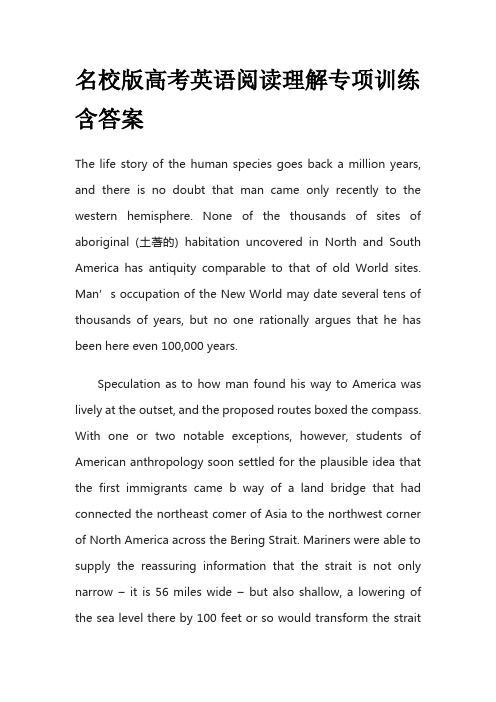
名校版高考英语阅读理解专项训练含答案The life story of the human species goes back a million years, and there is no doubt that man came only recently to the western hemisphere. None of the thousands of sites of aboriginal (土著的) habitation uncovered in North and South America has antiquity comparable to that of old World sites. Man’s occupation of the New World may date several tens of thousands of years, but no one rationally argues that he has been here even 100,000 years.Speculation as to how man found his way to America was lively at the outset, and the proposed routes boxed the compass. With one or two notable exceptions, however, students of American anthropology soon settled for the plausible idea that the first immigrants came b way of a land bridge that had connected the northeast comer of Asia to the northwest corner of North America across the Bering Strait. Mariners were able to supply the reassuring information that the strait is not only narrow –it is 56 miles wide –but also shallow, a lowering of the sea level there by 100 feet or so would transform the straitinto an isthmus (地峡). With little eels in the way of evidence to sustain the Bering Strait land bridge, anthropologists (人类学家) embraced the idea that man walked dryshod (不湿鞋的) from Asia to America.Toward the end of the last century, however, it became apparent that the Western Hemisphere was the New World not only for man but also for a host of animals and plants. Zoologists and botanists showed that numerous subjects of their respective kingdoms must have originated in Asia and spread to America. These findings were neither astonishing nor wholly unexpected. Such spread of populations is not to be envisioned as an exodus or mass migration, even in the case of animals. It is, rather, a spilling into new territory that accompanies increase in numbers, with movement in the direction of least population pressure and most favorable ecological conditions. But the immense traffic in plant and animal’s forms placed a heavy burden on the Bering Strait land bridge as the anthropologists ahead envisioned it. Whereas purposeful men could make their way across a narrow bridge, the slow diffusion of plant and animals would require an avenue as a continent and available for ages at a stretch.1.The movement of plants and animals form Asia to America indicates ______.A.that they could not have traveled across the Bering StraitB.that Asia and the Western hemisphere were connected by a large land massC.that the Bering Sea was an isthmus at one timeD.that migration was in the one direction only2.The author is refuting the notion that _____.A.life arose in America independently of life in EuropeB.the first settlers in America came during the sixteenth centuryC.a large continent once existed which has disappearedD.man was a host to animals and plants3.By using the words “boxed the compass “(in Line 7) the author implies that _____.A.the migration of mankind was from West to EastB.the migration of mankind was from East to WestC.mankind traveled in all directionsD.mankind walked from Asia to America4.One reason for the migration not mentioned by the author is _____.A.overcrowdingB.favorable environmental conditionsC.famineD.the existence of a land bridge5.We may assume that in the paragraph that follows this passage the author argues about______.A.the contributions of anthropologistB.the contributions of zoologists and botanistsC.the contributions made by the American IndiansD.the existence of a large land mass between Asia and North AmericaAcupuncture: magic needles针灸:神针One of the most famous Chinese medical treatments is the art of “magic needles”,or Chinese acupuncture. It was developed long ago,perhaps as early as 2000 BCE. There is evidence that acupuncture dates back to the Stone Age, when stone tools called bian were used to press areas of the body.“神针”,或称中国针灸,是最著名的中医疗法之一。
九分达人阅读

TIME
During the 19th century
TRAVELER DESTINATIO PURPOSE
N
OF TRAVEL
Colonial Asia, Africa To provide
administrat
information
or
for the
_______the
y set up
Meanwhile, European colonial administrators devoted numerous writings to the societies of their colonial subjects, particularly in Asian and African colonies they established.
疟疾的
14.Fascism n.法西斯
4.Mosquito(es) 蚊子 主义
5.Swamp n.沼泽地 15.Be vulnerable to
6.Life expectancy寿 易于患上…
命
16.Eradication n.根
除
1.Conquest n. 2.Malaria n. 3.Malaria-free 4.Mosquito(es) 5.Swamp n. 6.Life expectancy 7.Immense a. 8.Hereditary a.
社安排的旅游
8. Peak season/high season旅游旺季
9. Slack season/high season旅游旺季
10. Book a flight 预定航 班
11.Souvenir n.旅行纪念品 12.Jet lag 长途旅行之后的时
北京市清华大学2024年高三英语11月中学生标准学术能力诊断性测试试题含解析

A.Swim in a pool.B.Have a spa.
C.Explore medieval towns.D.Walk through olive groves.
2.Which destination is your best choice if you intend to travel to Europe after October?
【答案】1. C 2. A 3. D
【解析】
这是一篇应用文。文章主要介绍了秋天的四个欧洲之旅。
【1题详解】
细微环节理解题。依据The unknown Cilento部分“leaving modernity behind and venturing inland to medieval (中世纪的) hilltop towns.”可知,把现代化抛在脑后,去内陆的中世纪山顶城镇冒险。由此可知,在unknown Cilento可以探究中世纪的城镇。故选C。
Carpathian clambers
Poland and Slovakia are separated by the Carpathian Mountains and their large forest-filled valleys.Starting and ending in Krakow, this trip covers both countries.Some days include the option of climbing to snowy peaks or taking easier, lower-altitude options, and you’ll likely meet the Gorals — a culturally-distinct group known as “highlanders”.Most memorable activity will be walking along the300m-high Dunajec River to spa town Szczawnica.Seven nights £630, including transport, luggage transfers and walking st departure October 24.
9分达人 听力合集

9分达人听力合集English Response:Comprehension Questions:1. What is the first step in the process of developing critical thinking skills?Recognizing and challenging assumptions.2. Which of the following is NOT a characteristic of critical thinking?Open-mindedness.3. What is the purpose of using evidence in critical thinking?To support claims and arguments.4. How can critical thinking help you make better decisions?By evaluating information and considering different perspectives.5. Which of the following is an example of a critical thinking question?Why is the sky blue?6. What is the difference between argument and evidence?Argument is a claim supported by reasons, while evidence is factual information that supports arguments.7. How can critical thinking help you avoid logical fallacies?By identifying and understanding common errors in reasoning.8. What is the importance of metacognition in critical thinking?It allows you to monitor and evaluate your own thinking process.9. How can you apply critical thinking skills in everyday life?By questioning information, considering different perspectives, and making informed decisions.Discussion Questions:1. Describe a situation where you used critical thinking skills to solve a problem.2. Discuss the challenges you face in developing critical thinking skills.3. Explain how critical thinking can benefit you in your personal and professional life.中文回答:理解性问题:1. 培养批判性思维技能的第一步是什么?识别并挑战假设。
九分达人阅读答案3

篇一:九分达人阅读答案3摘要:九分达人阅读3电子版(pdf版)。
考生在复习雅思阅读考试时,要提前练习雅思阅读复习资料。
下面为大家整理了九分达人阅读3电子版, pdf版的,同学们可在复习雅思阅读考试时进行参考。
以下是九分达人阅读3电子版的部分内容,同学们可在复习考试阅读部分时,可多练习一些资料,这样能更好地运用雅思阅读考试复习技巧。
9分达人雅思阅读真题还原及解析3共分为三大部分:第一部分包括最新6套雅思阅读真题,每套题共有三篇阅读文章;考生应对所有文章精读细读,达到完全理解的水平,因为每篇文章都有可能在考试中再次出现。
第二部分包括词汇详解、题目详解和参考译文三个版块的内容。
词汇详解部分为文章及题目中出现的词汇提供了词性、准确的释义和其他拓展信息,既能帮助考生增加对真题的理解,又能扩充考生的词汇量。
题目详解部分则对本书收录的每套题目进行了详细解析,不仅帮助考生彻底弄懂每套试题,同时也教给考生相应的解题方法和技巧。
参考译文中的翻译准确流畅,考生对英语原文若有任何不理解之处,可利用参考译文帮助理解。
第三部分为6套雅思阅读真题的参考答案,可供考生进行自我检测。
内容截图以上就是九分达人阅读3的部分内容,同学们可在复习雅思阅读考试部分时,下载相关的雅思阅读考试资料进行训练。
相关推荐:篇二:九分达人阅读答案3第一次参加啊时间:23分钟(总是超时该怎么办?)错题:题号5 india 写成了bangalore。
原因:没有看清country 的要求问题:是非题有点心虚,尤其是10和11。
但居然都对了微凉发表于 2015-1-27 12:43 第一次参加啊时间:23分钟(总是超时该怎么办?)错题:题号5 india 写成了bangalore。
总超时是不是因为在某道题上花太多时间啦!不过只错了一题棒棒哒我前面已经出了两期啦,尽快赶上进度哦请教楼主,填空题总是少个the,还有就是有的文中没有原话可以摘抄,需要自己总结,请问这两种情况要怎么应对呢?queen 发表于 2015-1-28 20:47 请教楼主,填空题总是少个the,还有就是有的文中没有原话可以摘抄,需要自己总结,请问这两种情况要怎么应 ...能给出具体的题目吗?这样比较好解答643时间 21min。
9分达人雅思阅读5答案
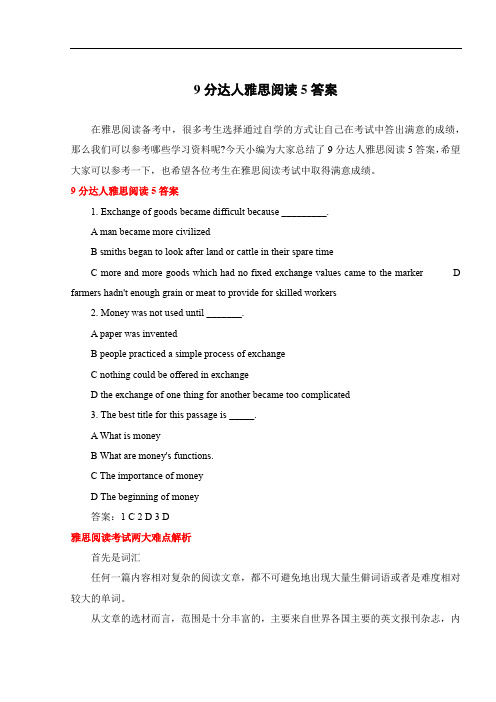
9分达人雅思阅读5答案在雅思阅读备考中,很多考生选择通过自学的方式让自己在考试中答出满意的成绩,那么我们可以参考哪些学习资料呢?今天小编为大家总结了9分达人雅思阅读5答案,希望大家可以参考一下,也希望各位考生在雅思阅读考试中取得满意成绩。
9分达人雅思阅读5答案1. Exchange of goods became difficult because _________.A man became more civilizedB smiths began to look after land or cattle in their spare timeC more and more goods which had no fixed exchange values came to the markerD farmers hadn't enough grain or meat to provide for skilled workers2. Money was not used until _______.A paper was inventedB people practiced a simple process of exchangeC nothing could be offered in exchangeD the exchange of one thing for another became too complicated3. The best title for this passage is _____.A What is moneyB What are money's functions.C The importance of moneyD The beginning of money答案:1 C 2 D 3 D雅思阅读考试两大难点解析首先是词汇任何一篇内容相对复杂的阅读文章,都不可避免地出现大量生僻词语或者是难度相对较大的单词。
中医针灸论文范文
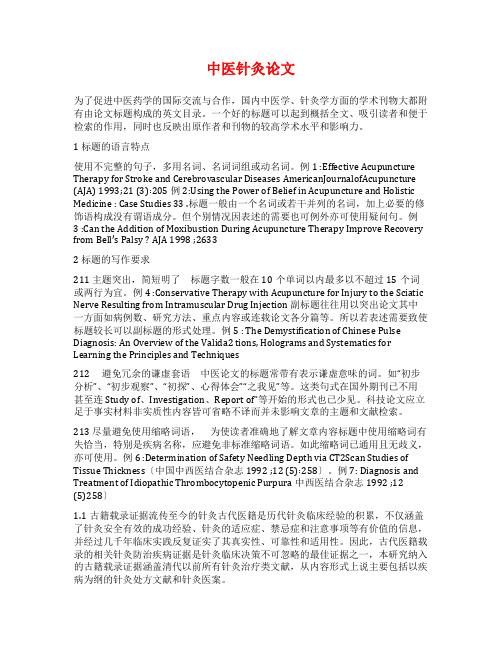
中医针灸论文为了促进中医药学的国际交流与合作,国内中医学、针灸学方面的学术刊物大都附有由论文标题构成的英文目录。
一个好的标题可以起到概括全文、吸引读者和便于检索的作用,同时也反映出原作者和刊物的较高学术水平和影响力。
1 标题的语言特点使用不完整的句子,多用名词、名词词组或动名词。
例1 :Effective Acupuncture Therapy for Stroke and Cerebrovascular Diseases AmericanJournalofAcupuncture (AJA) 1993;21 (3)∶205 例2:Using the Power of Belief in Acupuncture and Holistic Medicine : Case Studies 33 .标题一般由一个名词或若干并列的名词,加上必要的修饰语构成没有谓语成分。
但个别情况因表述的需要也可例外亦可使用疑问句。
例3 :Can the Addition of Moxibustion During Acupuncture Therapy Improve Recovery from Bell′s Palsy ? AJA 1998 ;26332 标题的写作要求211 主题突出,简短明了标题字数一般在10个单词以内最多以不超过15个词或两行为宜。
例4 :Conservative Therapy with Acupuncture for Injury to the Sciatic Nerve Resulting from Intramuscular Drug Injection 副标题往往用以突出论文其中一方面如病例数、研究方法、重点内容或连载论文各分篇等。
所以若表述需要致使标题较长可以副标题的形式处理。
例5 : The Demystification of Chinese Pulse Diagnosis: An Overview of the Valida2 tions, Holograms and Systematics for Learning the Principles and Techniques212 避免冗余的谦虚套语中医论文的标题常带有表示谦虚意味的词。
9分达人阅读4test2 the significant
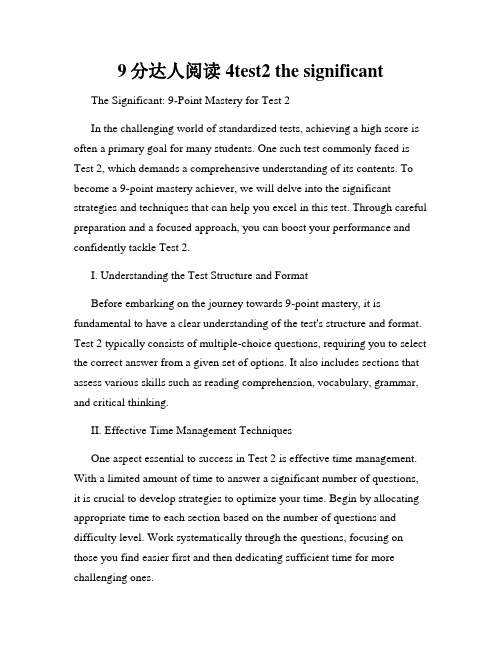
9分达人阅读4test2 the significant The Significant: 9-Point Mastery for Test 2In the challenging world of standardized tests, achieving a high score is often a primary goal for many students. One such test commonly faced is Test 2, which demands a comprehensive understanding of its contents. To become a 9-point mastery achiever, we will delve into the significant strategies and techniques that can help you excel in this test. Through careful preparation and a focused approach, you can boost your performance and confidently tackle Test 2.I. Understanding the Test Structure and FormatBefore embarking on the journey towards 9-point mastery, it is fundamental to have a clear understanding of the test's structure and format. Test 2 typically consists of multiple-choice questions, requiring you to select the correct answer from a given set of options. It also includes sections that assess various skills such as reading comprehension, vocabulary, grammar, and critical thinking.II. Effective Time Management TechniquesOne aspect essential to success in Test 2 is effective time management. With a limited amount of time to answer a significant number of questions, it is crucial to develop strategies to optimize your time. Begin by allocating appropriate time to each section based on the number of questions and difficulty level. Work systematically through the questions, focusing on those you find easier first and then dedicating sufficient time for more challenging ones.III. Improving Reading Comprehension SkillsA key component of Test 2 is the reading comprehension section, which evaluates your ability to understand and analyze written passages. To enhance your reading comprehension skills, practice reading a variety of texts from different genres. Pay attention to the main ideas, supporting details, and the author's tone. Test yourself by summarizing the key points and identifying any implicit arguments or assumptions made by the author.IV. Expanding Vocabulary KnowledgeA rich vocabulary is essential for answering Test 2 questions correctly. To expand your vocabulary, make use of resources such as English dictionaries, word lists, and flashcards. Engage in regular vocabulary-building exercises to learn and retain new words effectively. Additionally, try to incorporate these newly learned words into your daily conversations and written work to reinforce your understanding.V. Strengthening Grammar and Usage SkillsThe grammar and usage section of Test 2 assesses your understanding of sentence structure, punctuation, and word usage. To strengthen these skills, review grammar rules and practice identifying common grammatical errors. Focus on areas such as subject-verb agreement, verb tenses, pronoun usage, and sentence fragments. Constant practice and revision will assist in solidifying your grammatical foundation.VI. Enhancing Critical Thinking AbilitiesCritical thinking ability plays a significant role in test performance. Test 2 includes questions that evaluate your logical reasoning, problem-solving,and analytical skills. Develop these abilities by engaging in activities that promote critical thinking, such as puzzles, brainteasers, and logic games. Practice analyzing arguments, identifying fallacies, and drawing logical conclusions to sharpen your critical thinking skills.VII. Utilizing Practice Tests and Sample QuestionsTo optimize your test preparation, take advantage of practice tests and sample questions. These resources provide valuable insight into the test format, question types, and difficulty level. Practice answering questions under timed conditions to simulate the test experience and build your confidence. Review your answers, identifying areas of improvement and understanding the reasoning behind correct responses.VIII. Seeking Support and GuidanceWhile preparing for Test 2, do not hesitate to seek support from teachers, tutors, or study groups. Collaborating with others who share the same goal allows for the exchange of ideas, insights, and study strategies. Additionally, consider enrolling in test preparation courses specifically designed for Test 2, as they offer targeted instruction and practice materials.IX. Maintaining a Positive MindsetLastly, maintaining a positive mindset is crucial for success in any endeavor, including Test 2. Believe in your abilities and approach the test with confidence. Remember to manage test-related anxiety by practicing relaxation techniques and adopting a well-balanced study routine. A positive attitude will not only enhance your performance but also make the learning journey more enjoyable.In conclusion, becoming a 9-point mastery achiever in Test 2 requires a combination of strategic preparation, focused study, and a positive mindset. By understanding the test structure, managing time effectively, and honing essential skills such as reading comprehension, vocabulary, grammar, and critical thinking, you can embark on your journey towards test success. Utilize practice materials, seek support when needed, and approach the test with confidence. With hard work and dedication, you can achieve the significant score you desire in Test 2.。
雅思阅读9分达人1答案

篇一:雅思阅读9分达人1答案摘要:9分达人雅思阅读真题还原与解析1pdf免费赠送。
9分达人雅思阅读1是许多网友都使用的资料,以下为大家汇总整理了9分达人雅思阅读真题还原与解析1相关的内容,pdf 版的,同学们可下载进行使用。
很多同学在找9分达人阅读这本书,应各位雅思考生的要求,以下为大家搜集了pdf版的9分达人真题,有需要的同学们可适当进行下载参考。
9分达人雅思阅读真题还原第一部分包括七套雅思阅读真题,每套题共有三篇阅读文章;考生应对所有文章精读细读,达到完全理解的水平,因为每篇文章都有可能在考试中再次出现。
第二部分对9分达人雅思阅读真题还原及解析收录的每套题目进行了详细的解析,不仅帮助考生彻底弄懂每套试题,同时也教给考生相应的解题方法和技巧。
第三部分为七套真题的参考答案,考生可进行自我检测。
附录部分独家抢先收录了2011年1月8日最新阅读真题,考生可一读为快。
内容截图剑桥雅思真题精讲9是同学们考试记忆的重点资料,同学们可下载进行运用。
相关推荐:篇二:雅思阅读9分达人1答案论坛中已经有了,现在奉上1,供大家下载。
简介:9分达人阅读真题还原及解析共分为三大部分:第一部分包括七套雅思阅读真题,每套题共有三篇阅读文章;考生应对所有文章精读细读,达到完全理解的水平,因为每篇文章都有可能在考试中再次出现。
第二部分对9分达人雅思阅读真题还原及解析收录的每套题目进行了详细的解析,不仅帮助考生彻底弄懂每套试题,同时也教给考生相应的解题方法和技巧。
第三部分为七套真题的参考答案,考生可进行自我检测。
附录部分独家抢先收录了2011年1月8日最新阅读真题,考生可一读为快。
评价:书里面包含了2011-2007年得8套阅读真题,可以真刀真枪的做雅思阅读,建议大家自学者可以购买,习题的讲解也很详细。
书里面的每一篇文章都选得很经典,考到的几率也很大,关键是书里介绍的做阅读的方法个人觉得很实用,只要吃透了方法,基本在时间充足的情况下月的不会错,建议对阅读还比较迷茫的同学们入手一本吧。
九分达人阅读

17.Vengeance n.复仇
9. Culprit n.犯人,罪魁祸首 19.Lucrative a.有利可图的 10.Mosquito bites蚊子叮咬 20.A dose of 一剂(量)
1.Conquest n. 2.Malaria n. 3.Malaria-free 4.Mosquito(es)
T7P2
The conquest of Malaria in Italy, 1900-1962
1. Conquest n.征服,战胜 2. Malaria n.疟疾 4. Mosquito(es) 蚊子 5. Swamp n.沼泽地 6. Life expectancy寿命 7. Immense a.巨大的
11.Hostility n. 12.Refusal n. 13.Be subjected to 14.Fascism n.
5.Swamp n.
6.Life expectancy
15.Be vulnerable to
16.Eradication n.
7.Immense a.
8.Hereditary a.
九分达人阅读2
T1P3 Travel Books
1. 2. 3. 4. 5.
Fragmentary a.零碎的, 残缺不全的 Prominent a.著名的,卓 越的
12.
Venture v.冒险
13.
14.
Buddhist n.佛教徒
Enlightenment n.启蒙 Medieval a.中世纪的 Counterpart n.对应的人 或物 Oceania n.大洋洲 Conqueror n.征服者 Missionary n.传教士 Churn out 大量生产,粗 制滥造 Insatiable a.无法满足的, 贪得无厌的
9分达人阅读4test2 the significant
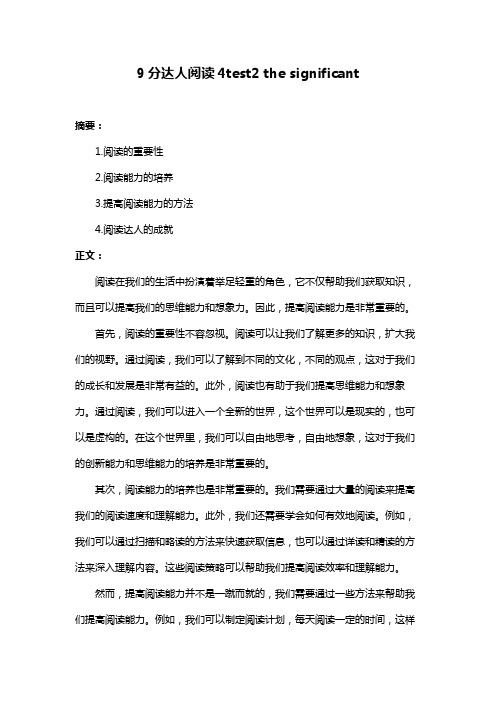
9分达人阅读4test2 the significant摘要:1.阅读的重要性2.阅读能力的培养3.提高阅读能力的方法4.阅读达人的成就正文:阅读在我们的生活中扮演着举足轻重的角色,它不仅帮助我们获取知识,而且可以提高我们的思维能力和想象力。
因此,提高阅读能力是非常重要的。
首先,阅读的重要性不容忽视。
阅读可以让我们了解更多的知识,扩大我们的视野。
通过阅读,我们可以了解到不同的文化,不同的观点,这对于我们的成长和发展是非常有益的。
此外,阅读也有助于我们提高思维能力和想象力。
通过阅读,我们可以进入一个全新的世界,这个世界可以是现实的,也可以是虚构的。
在这个世界里,我们可以自由地思考,自由地想象,这对于我们的创新能力和思维能力的培养是非常重要的。
其次,阅读能力的培养也是非常重要的。
我们需要通过大量的阅读来提高我们的阅读速度和理解能力。
此外,我们还需要学会如何有效地阅读。
例如,我们可以通过扫描和略读的方法来快速获取信息,也可以通过详读和精读的方法来深入理解内容。
这些阅读策略可以帮助我们提高阅读效率和理解能力。
然而,提高阅读能力并不是一蹴而就的,我们需要通过一些方法来帮助我们提高阅读能力。
例如,我们可以制定阅读计划,每天阅读一定的时间,这样可以帮助我们养成良好的阅读习惯。
此外,我们还可以参加一些阅读活动,如读书俱乐部、阅读比赛等,这样可以激发我们的阅读兴趣,提高我们的阅读能力。
最后,阅读达人的成就也是我们不能忽视的。
阅读达人通过他们的阅读能力和阅读习惯,取得了许多令人瞩目的成就。
例如,他们可以通过阅读快速获取信息,从而在竞争中取得优势。
他们还可以通过阅读提高他们的思维能力和想象力,从而在生活中取得更大的成功。
总的来说,阅读的重要性和阅读能力的培养是非常重要的。
我们可以通过一些方法来提高我们的阅读能力,如制定阅读计划、参加阅读活动等。
九分达人阅读

参考词组
Sample fine cuisine in France Experience the ancient splendour of the Egyptian pyramids
Breathe the pristine air of the Himalayan mountain range
TIME
TRAVELER
DESTINATIO PURPOSE N OF TRAVEL
During the 19thfrica To provide administrat information or for the _______the y set up
T7P2
The conquest of Malaria in Italy, 1900-1962
1. Conquest n.征服,战胜 2. Malaria n.疟疾 4. Mosquito(es) 蚊子 5. Swamp n.沼泽地 6. Life expectancy寿命 7. Immense a.巨大的
Satisfy curiosity about the large world Tourism enabled consumers to get away from home to see the sights in Rome, take a cruise through the Caribbean, walk the Great Wall of China, visit some wineries in Bordeaux, or go on safari in Kenya.
28 NOT GIVEN
29 NO
30 NO
31 YES
32 controversial
- 1、下载文档前请自行甄别文档内容的完整性,平台不提供额外的编辑、内容补充、找答案等附加服务。
- 2、"仅部分预览"的文档,不可在线预览部分如存在完整性等问题,可反馈申请退款(可完整预览的文档不适用该条件!)。
- 3、如文档侵犯您的权益,请联系客服反馈,我们会尽快为您处理(人工客服工作时间:9:00-18:30)。
Chinese Pulse DiagnosisThe examination of the pulse is a subtle skill in Traditional Chinese Medicine (TCM); however it provides a comprehensive diagnosis of the condition of practically the entire human body, from the more obvious heart rate to the condition of each internal organ. It is estimated that a pulse reading traditionally accounts for up to 30% of a TCM diagnosis, which is quite surprising to many Westerners. Although many Westerners may have heard of other diagnostic methods like inspecting (general physical observations of the patient), listening (breathing, coughing, voice quality) and inquiring (current symptoms and past medical history), pulse reading as a tool to determine physical condition is not common knowledge. It is therefore worth taking a closer look at how illnesses are identified using this ancient medical skill which dates back more than 2000 years.The reason such a small area on the wrist can give a traditional Chinese medical practitioner such a thorough indication of a person's well-being is the fact that each wrist is divided into 9 regions along the radial artery. There are 3 positions on the wrist which are used for analysis: the front, middle and rear positions, and analysed at 3 different levels: superficial, middle and deep.On the left wrist, the front position focuses on the condition of the heart and small intestine, the middle position concentrates on the functions of the liver and gall bladder, and the rear position indicates the status of the kidney and bladder. The lungs and large intestine are the centre of attention in the front position on the right wrist, with the middle position focusing on the spleen and stomach and the rear position taking note of the 'Gate of Vitality Fire'. This is the body's motivating force and provider of heat for all bodily functions.In regards to the various levels, the superficial level reflects the state of Qi (energy) as well as the health of the Yang organs (small/large intestine, gal1 bladder, stomach and bladder), the middle level shows the state of blood flow, and the deep level is an indication of the state of the Yin organs (the heart, liver, lungs, spleen, and kidneys).Supposing that the pulse in the left middle position was soft and smooth, neither superficial nor deep, it would suggest that the liver and gall bladder are in a good state of health. However if the patient's pulse feels harder or tighter than normal and is more superficial and pounding, it may result in his/her suffering from a headache or migraine as the excessive liver fire rises up through the gall bladder channel to the head.Diagnosing patients through pulse examination is actually much more complicated, due to the fact that practitioners need to be able to identify 26 different pulse categories. Some of these categories are more significant for practitioners in the modern day setting than others. For example, today Chinese doctors hopefully would rarely come across a scattered pulse which is irregular and hardly perceptible, a sign that a patient is critically ill and nearing death. Other pulse categories which suggest extreme illness include the intermittent, swift, hollow, faint, surging and hidden pulse. More commonly observed pulse categories include the rapid pulse, which increases infrequency (more than 90 beats per minute) and may be indicative of a fever, or the tense pulse, which feels like a stretched cord, and may suggest that the patient has a cold or is suffering from pain. Many pulses only have subtle differences or are the combination of several pulses; thus, pulse examination is often seen as being more than just a skill but an actual art form.This kind of medical diagnosis can be affected by a number of factors, so before any examination, it is important that patients are in a relaxed physical and mental state so they can get the most accurate reading. The morning is often the best time to take such a reading, as a busy day in the office or vigorous exercise before seeing the doctor can influence the quality of the pulse. Secondly, both the patient's and the doctor's arm, hand, wrist and fingers must be relaxed and in the correct position. Thirdly, the right amount of pressure must be applied by the doctor for the right duration of time in order to be effective. Even seasonal influences need to be taken into account. In the spring, the pulse tends to be slightly taut; in summer, it is slightly fuller and surging. The autumn pulse is somewhat floating, fine and soft while the winter pulse is rather sinking and slippery or hard. Patients' characteristics are also of importance. Children, for instance, have quick pulses, athletes have slower than usual ones, and obese people have deeper ones. Women have stronger right pulses than their left, as opposed to men where the opposite is true. Finally drug use, either pharmaceuticals or narcotics, can have an influence on a patient's pulse.The basic form of a patient's pulse will be able to tell a doctor whether the function being observed is at the body's surface or interior, whether it is hot or cold in nature, and whether an excess or deficiency in that particular function exists. It ought to be remembered that pulse examination does not replace other types of medical diagnosis, which also play an integral role in the overall prognosis of the patient.Questions 1-2Complete the sentences below using information from Reading Passage.Write NO MORE THAN TWO WORDS for each answer.1 Pulse reading is a tool used by Chinese medical practitioners to __________ the state of apatient's health,2 Diagnostic tools, such as inspecting, listening and inquiring to analyse a patient's condition,are much more __________ than pulse examination.Questions 3-4Complete the diagram below.Write ONLY ONE WORD for each answer.Right HandQuestions 5- 7Complete the table below.Write NO MORE THAN THREE WORDS for each answer.Questions 8-9Choose the appropriate letters A-H.Which TWO factors are NOT mentioned as possibly influencing the accuracy of a pulse reading?A Physical examinationB Time of dayC WorkD Position of upper limbsE Amount of force usedF ClimateG Illegal substancesH ChemistsQuestions 10-12Do the following statements agree with the information given in Reading Passage? Write TRUE if the statement is true according to the passageFALSE if the statement is false according to the passageNOT GIVEN if the information is not given in the passagePulse TypeDescription Possible Condition(s) ScatteredNot obvious/intermittent Almost _____5_____ _____6_____Intensifying beats per second High temperature Tight _____7_____ Flu, aches & sorenessLarge _____3_____ Gate of Vitality Fire _____4_____ and digestive organ10 Most Westerners are intrigued by Chinese pulse diagnosis.11 Your liver is probably fine if the pulse on the right wrist is soft and smooth in the middleposition.12 Pulse diagnosis is one part of a broader medical examination.Question 13Choose the appropriate letter A-D.13 The writer believes pulse readingA is simplistic in nature.B is unimportant and no longer necessary.C requires practitioners to be familiar with Chinese history.D requires lengthy study and practice.。
